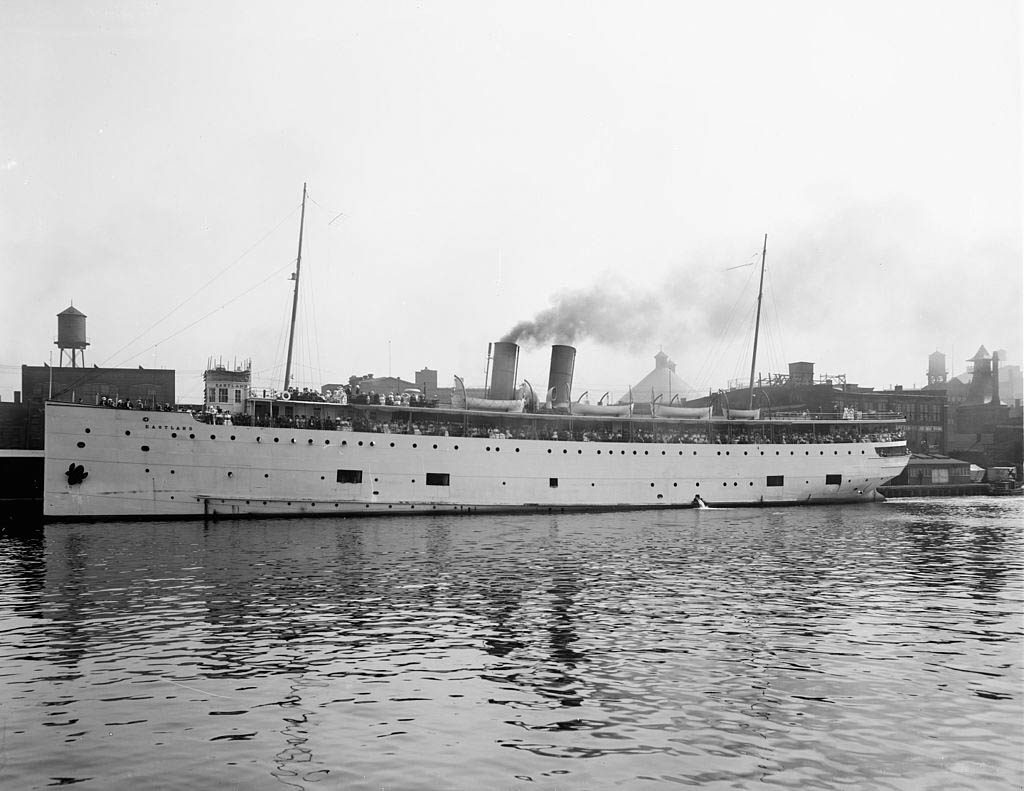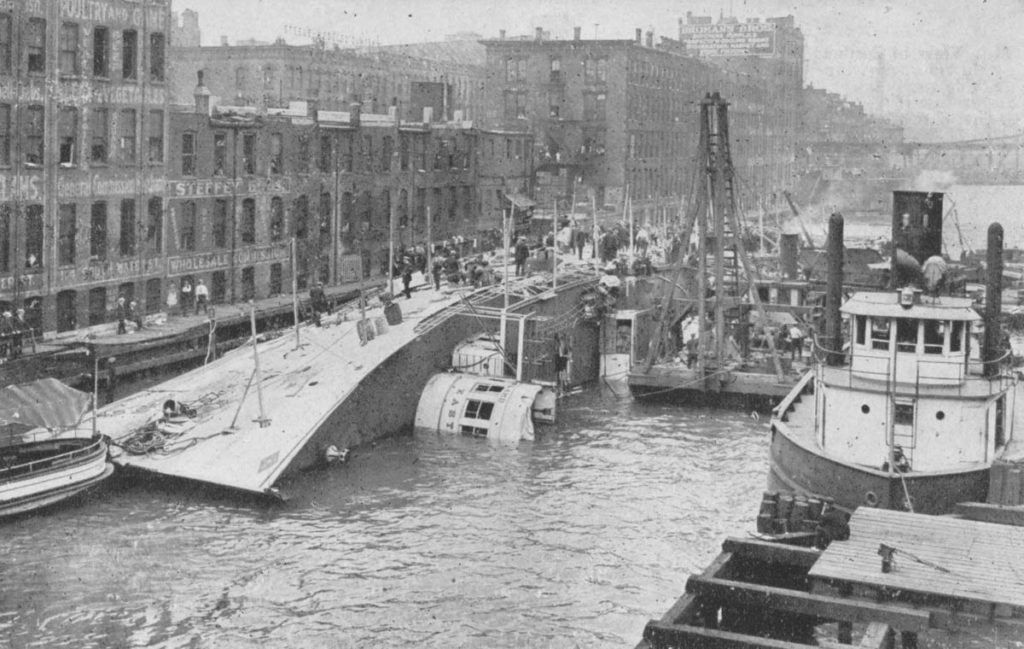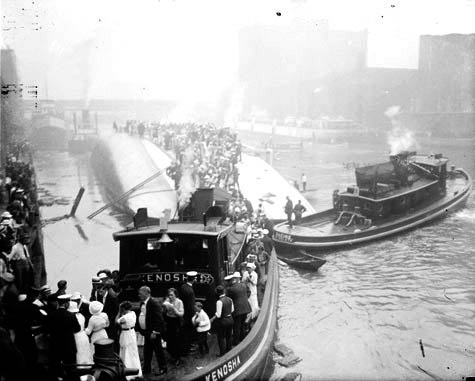Known as “The Blue-Collar Titanic”, in 1915 a passenger ship named the Eastland capsized in the Chicago River. It remains the worst maritime tragedy in Great Lakes history with a total loss of 844 passengers and crew.
The ship was commissioned by the Michigan Steamship Company during 1902 and designed by the Port Huron, Michigan, Jenks Ship Building Company. The ship was called Eastland in May 1903, immediately prior to its inaugural voyage.
For its issues, the Eastland was not without. She hit the laid-up tugboat George W. Gardner on its inaugural season in 1903 and sank her at the dock at Lake Street Bridge, Chicago, Illinois, but only sustained minor damage herself. There was also a mutiny on the Eastland a month after she hit the tugboat. Six of the ship’s firemen declined to stoke the ship’s boiler fire saying that they had not received their potatoes at their meal. Captain John Pereue ordered the six men arrested at gunpoint when they refused to return to the fire pit. Firemen George Lippen and Benjamin Myers, not in the six-person party, stoked the flames as the vessel headed to the harbour.

The six men that mutinied – Glenn Watson, Mike Davern, Frank La Plarte, Edward Fleming, Mike Smith, and William Madden – were taken to the town’s lock-up upon the ship’s arrival in South Haven and charged with mutiny. Captain Pereue was replaced shortly after.
In 1903 the Eastland journeyed for improvements to Port Huron, Michigan, including the addition of an air conditioning system and machinery changes to minimise draught. While the improvements increased the speed of the ship, they added additional weight and decreased its draught, thus reducing the metacentric height and the inherent stability as originally intended. Upon her return to South Haven in May 1904, following repairs, while loading and unloading cargo and passengers, encountered occasional problems with its stability. On 17 July 1904, after leaving South Haven with approximately 3,000 passengers the Eastland nearly capsized. Her capacity was eventually reduced to 2,800 passengers, cabins removed, lifeboats added and the hull repaired.
On 24 July 1915, the SS Eastland and four other passenger steamers from the Great Lakes were chartered to carry employees from the Hawthorne Works of the Western Electric Company in Cicero, Illinois to a picnic in Michigan City, Indiana. This was a significant event in the lives of the workers, many of whom were unable to have holidays.
On the morning of July 24, passengers started boarding Eastland between Clark and LaSalle Streets on the south side of the Chicago River around 6:30 a.m., and by 7:10 a.m. the ship had reached its capacity of 2,572 passengers. The ship was full, with many passengers standing on the open upper decks, and the port side (away from the wharf) started to list slightly. By allowing water into its ballast tanks, the crew tried to stabilize the ship, but to no avail. Sometime over the next 15 minutes, several passengers rushed to the port side, and at 7:28 a.m. Eastland plunged sharply to shore, then rolled entirely to its port side, to rest on the bottom of the water, which was just 20 feet (6.1 m) below the surface; barely half of the vessel was submerged. Some passengers had already moved below decks on this relatively cool and damp morning to warm-up before departure.
As a result, the water and the sudden rollover trapped hundreds of people inside; others were crushed by heavy furniture, including pianos, bookcases, and chairs. A total of 844 passengers and four crew members died in the tragedy, despite the swift response by the crew of a nearby vessel, Kenosha, who came alongside the hull to allow those trapped on the capsized vessel to get to safety.
Writer Jack Woodford witnessed the tragedy and gave the Herald and Examiner, a newspaper in Chicago, a firsthand account. Woodford writes, in his autobiography:
“And then a movement caught my eye. I looked across the river. As I watched in disoriented stupefaction a steamer large as an ocean liner slowly turned over on its side as though it were a whale going to take a nap. I didn’t believe a huge steamer had done this before my eyes, lashed to a dock, in perfectly calm water, in excellent weather, with no explosion, no fire, nothing. I thought I had gone crazy.”
A grand jury indicted the president and three other steamship company officers for manslaughter, and the ship’s captain and engineer for criminal carelessness, and found the accident to be caused by “conditions of chaos” caused by any or all overloading of passengers, mishandling of water ballast, or shipbuilding.
She was sold to the Illinois Naval Reserve after being raised on 14 August 1915, recommissioned a the USS Wilmette and stationed at the Great Lakes Naval Base. She was converted to a gunboat, renamed Wilmette on February 20, 1918, and commissioned to serve in World War I. It qualified seamen and performed regular maintenance and repairs. It was removed from commission in 1940.
On 4 June 1989, a plaque to remember the accident was erected. On 26 April 2000, this marker was stolen, and on 24 July 2003, a new marker was installed and rededicated.








